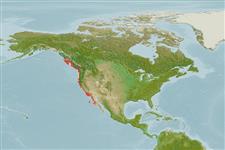>
Gobiiformes (Gobies) >
Gobiidae (Gobies) > Gobiinae
Etymology: Rhinogobiops: Greek, rhinos = nose + Latin, gobius = gudgeon Greek, ops = similar to; nicholsii: Named after Capt. H.E. Nichols, U.S.N, its discoverer (Ref. 6885).
Eponymy: Captain Henry Ezra Nichols (d: 1899) was a US Navy officer at the Department of Alaska. [...] (Ref. 128868), visit book page.
More on author: Bean.
Environment: milieu / climate zone / depth range / distribution range
Écologie
marin démersal; profondeur 0 - 106 m (Ref. 2850). Subtropical; 55°N - 27°N, 136°W - 114°W
Eastern Pacific: Wales Island, northern British Columbia, Canada to Punta Rompiente, central Baja California, Mexico.
Taille / Poids / Âge
Maturity: Lm ? range ? - ? cm
Max length : 15.0 cm TL mâle / non sexé; (Ref. 2850); âge max. reporté: 5 années (Ref. 56049)
Description synthétique
Clés d'identification | Morphologie | Morphométrie
Épines dorsales (Total) : 5 - 7; Rayons mous dorsaux (Total) : 12 - 14; Épines anales: 0; Rayons mous anaux: 11 - 12. Caudal rounded.
Found usually in sandy areas near rocks. Occurs from intertidal areas to 106 m depth. Retreats to rocks or holes when approached. Young are found usually offshore among plankton. Oviparous (Ref. 56079). A protogynous hermaphrodite (Ref. 34256). Forms permanent harem groups composed of a single male and several smaller females (Ref. 55367). Eggs are guarded by the male (Ref. 56079).
Nesting occurs from April-October. Male cleans spawning site under rock, then attracts female by rising from bottom to display his black pelvic disk. Male guards nest after female lays eggs. Protogynous (Ref. 13452, 35501). Sex reversal is completed in less than 5 months (Ref. 34185, 34256). A monandric species (Ref. 55367). Length at sex change = 6.9 cm TL (Ref. 55367). Also Ref. 103751.
Eschmeyer, W.N., E.S. Herald and H. Hammann, 1983. A field guide to Pacific coast fishes of North America. Boston (MA, USA): Houghton Mifflin Company. xii+336 p. (Ref. 2850)
Statut dans la liste rouge de l'IUCN (Ref. 130435: Version 2024-1)
Menace pour l'homme
Harmless
Utilisations par l'homme
Pêcheries: commercial; Aquarium: Aquariums publics
Outils
Articles particuliers
Télécharger en XML
Sources Internet
Estimates based on models
Preferred temperature (Ref.
123201): 8.3 - 12.8, mean 9.8 °C (based on 66 cells).
Phylogenetic diversity index (Ref.
82804): PD
50 = 1.0000 [Uniqueness, from 0.5 = low to 2.0 = high].
Bayesian length-weight: a=0.01023 (0.00477 - 0.02194), b=3.01 (2.83 - 3.19), in cm total length, based on LWR estimates for this (Sub)family-body shape (Ref.
93245).
Niveau trophique (Ref.
69278): 3.4 ±0.58 se; based on food items.
Résilience (Ref.
120179): Milieu, temps minimum de doublement de population : 1,4 à 4,4 années (tmax=5).
Fishing Vulnerability (Ref.
59153): Low vulnerability (10 of 100).
Nutrients (Ref.
124155): Calcium = 162 [79, 343] mg/100g; Iron = 1.32 [0.70, 2.56] mg/100g; Protein = 18.5 [16.6, 20.1] %; Omega3 = 0.4 [0.2, 0.7] g/100g; Selenium = 21.9 [10.9, 43.4] μg/100g; VitaminA = 18.8 [5.8, 59.0] μg/100g; Zinc = 1.06 [0.73, 1.59] mg/100g (wet weight);
